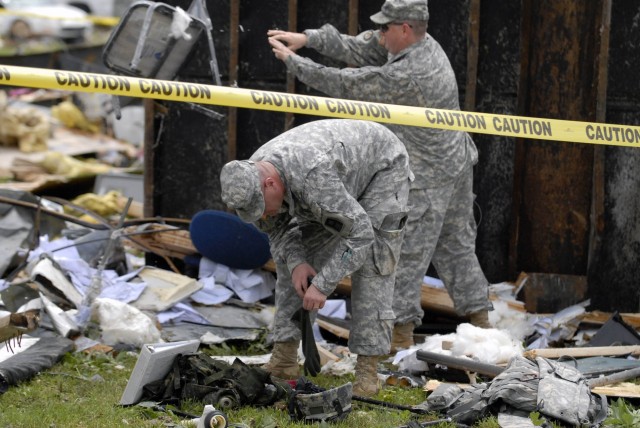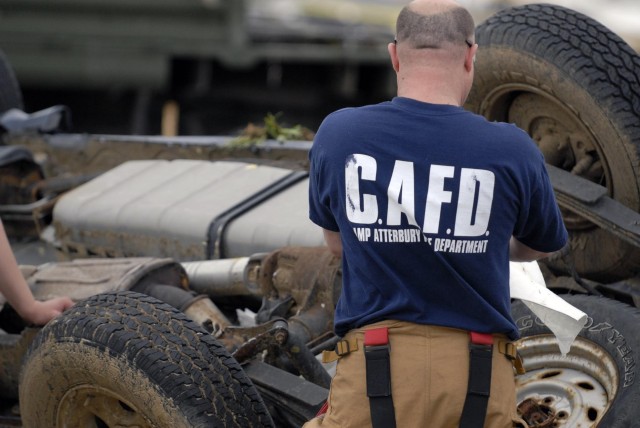CAMP ATTERBURY, Ind. (Army News Service, June 6, 2008) - It could have easily been a scene out of a blockbuster natural disaster movie after two tornadoes ripped through Camp Atterbury within 10 minutes of each other Tuesday, but instead Soldiers, Marines and civilians regrouped, restored power, and resumed training.
With large metal shipping containers tossed around like Legos and sports utility vehicles crushed into subcompact cars, Col. Barry L. Richmond, installation commander, said it was a blessing that none of the more than 3,500 people on the installation were killed or injured.
By day break, Camp Atterbury assembled a large engineering staff of Soldiers and civilian experts to assess the structural damage of the buildings and start the process of rebuilding one of the Army's premiere training centers for soldiers deploying to Kosovo, Afghanistan and Iraq.
"We started at 6:30 a.m. to determine the things we needed to accomplish to support the Soldiers here on Camp Atterbury during their training," said Lt. Col. Ron Morris, deputy installation commander said about Camp Atterbury moving forward with training service members to deploy overseas. "Our goal was not to constrain their training what so ever."
The damaged extended to much more than the 50 buildings. Sunrise also brought a harsh reality to the real power of a tornado as military and civilian vehicles, power lines, fences and other infrastructure sustained heavy damage during the short ordeal.
"The second thrust after the storm was to make sure everything was safe and to get the power turned back on," Morris said. "We have 3,500 Soldiers currently training on Camp Atterbury and we need to get things up and operational to support everything on the installation."
Morris said the damage was consolidated to the garrison area where administration and logistics functions were effected, but said all the training areas south of the installation were untouched.
"Training is up and running at full strength," said Morris.
With close eyes on the weather radar, Richmond knew as the storm approached Camp Atterbury this could go from bad to worse, but never expected what he saw and only hoped no one was injured.
"There's a lot of damage here and we are very fortunate," Richmond said. "I was here last night when the tornado hit and drove around looking at all the damage after the storm."
Utility companies spent much of the next two days restoring or stabilizing services to the site.
"I'm happy to say that we have been able to conduct and support their training in the exact same way if the storm hadn't hit," Morris said. "Clean up continues and power has been restored to 95 percent of the installation. The gas lines that were ruptured have been repaired and now we look at cleaning up the debris."
Richmond said the first mission minutes after the "all clear" of the tornado was 100 percent accountability of all the Soldiers, Marines and civilians here.
"It is amazing that no one was injured," as he pointed to the evidence of destroyed buildings and Humvees behind him. "That's the real miracle and we were blessed by God that not a single Soldier or Marine who was on this base was hurt during this awful storm."
He said the number one concern at any time is the safety of service members and civilians on the installation.
Richmond and Col. Christopher M. Holden, the 205th Infantry Brigade commander in charge of training at Camp Atterbury, spent hours before the storm preparing for the worst by adjusting training and moving service members to safe areas.
The quick implementation of standard safety procedures was key in preventing injuries as well as allowing training to resume as quickly as possible according to Morris.
"We do have tornado drills that we test every Friday at noon, and it was fortunate it was working before the installation lost power," he said.
That alarm and the service member's quick response to potential danger saved lives Tuesday evening.
With the storm gone, power restored and as clean up crews begin the all-encompassing task of cleaning tons of debris, Camp Atterbury and the 205th Infantry Brigade can concentrate on doing what they do best - providing the best, most realistic training for service members deploying overseas.
"We delayed our training for two hours -- so minimal impact," Holden said Wednesday. "We mitigated the effects of the thunderstorm yesterday by finishing up our outside transportation training early and got them all in hardstand buildings prior to the storms due to the installations weather storm warnings, which were truly the primary reason we were able to successfully prevent any injuries."
"Training will go as scheduled," he said.








Social Sharing